Hakama
はかま 袴
Hakama is a generic term for a variety of styles of skirt-like trousers. Certain types of hakama were common streetwear in the Edo period. In the noh, these streetwear hakama are worn together with crested black kimono (monzuki) for all the non-acting roles and by the actors for"uncostumed" performances ("hakama nō).
Hakama-style garments can also be costumes and are worn by both male or female characters. The various types of costume hakama are differentiated by construction, material, color, and decoration. They are worn on top of undergarments, such as noshime or atsuita. Often outer robes, like kariginu or karaori in tsuboori draping, are draped over the hakama-style garments.
Noh Kyogen
Types and Roles
In noh, ankle-length streetwear hakama are worn by the chorus members (ji-utai 地謡), instrumentalists (hayashi 囃子), and stage attendants (kōken 後見). Kyōgen characters wear ankle-length, hemp han-bakama 半袴 decorated with stencil-patterned scattered roundels. This kind of hakama is donned in combination with kataginu 肩衣 vests for roles of commoners, like the servants Tarō-kaja and Jirō-kaja. For messangers, laborers, temple workers, and minor shrine deities, the hakama are bound and secured to the calf: "tied hakama" or kukuri-bakama 括袴. Daimyō and samurai wear long trailing nagabakama 長袴 as a part of their matched suits, suō 素襖. High-ranking men and women wear ōkuchi 大口, while supernatural deities and demons wear hangiri 半切.
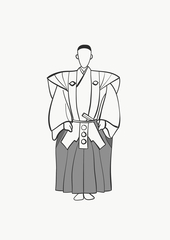
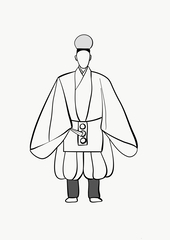
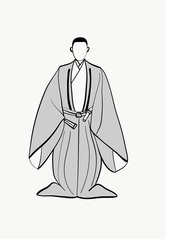
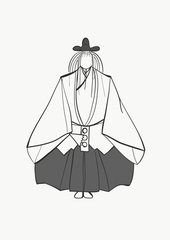
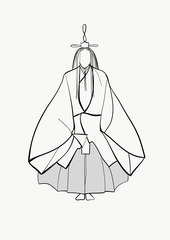
Tailoring
Hakama have separate front panels and back panels, which are sewn together to form "legs" from mid-thigh level down. The front panels have several deep pleats stitched in place at the top where they are tucked into a long cloth band that is used to tie the front panels to the wearer's waist. The back has two panels that are given a deep tuck at the top. The tuck may be sewn onto a reinforced back piece attached to sashes to tie the back panels to the body, or for variants with stiff back panels, like the ōkuchi and hangiri, the tucks may be opened out for storage and in preparation for dressing be formed by tightening cords strung through holes at the top of the panels. The standard hakama form a small bump at the upper back, while those with stiff back panels form a large mound over the upper back portion.
Contributor
Monica Bethe